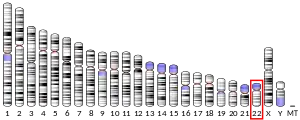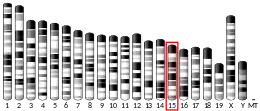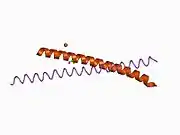Activating transcription factor 4 (tax-responsive enhancer element B67), also known as ATF4, is a protein that in humans is encoded by the ATF4 gene.[5][6]
Function
This gene encodes a transcription factor that was originally identified as a widely expressed mammalian DNA binding protein that could bind a tax-responsive enhancer element in the LTR of HTLV-1. The encoded protein was also isolated and characterized as the cAMP-response element binding protein 2 (CREB-2). ATF4 is not a functional transcription factor by itself but one-half of many possible heterodimeric transcription factors. Because ATF4 can simultaneously participate in multiple distinct heterodimers, the overall set of genes that require ATF4 for maximal expression in a specific context (ATF4-dependent genes) can be a mixture of genes that are regulated by different ATF4 heterodimers, with some ATF4-dependent genes activated by one ATF4 heterodimer and other ATF4-dependent genes activated by other ATF4 heterodimers.[7]
The protein encoded by this gene belongs to a family of DNA-binding proteins that includes the AP-1 family of transcription factors, cAMP-response element binding proteins (CREBs) and CREB-like proteins. These transcription factors share a leucine zipper region that is involved in protein–protein interactions, located C-terminal to a stretch of basic amino acids that functions as a DNA-binding domain. Two alternative transcripts encoding the same protein have been described. Two pseudogenes are located on the X chromosome at q28 in a region containing a large inverted duplication.[8]
ATF4 transcription factor is also known to play role in osteoblast differentiation along with RUNX2 and osterix.[9] Terminal osteoblast differentiation, represented by matrix mineralization, is significantly inhibited by the inactivation of JNK. JNK inactivation downregulates expression of ATF-4 and, subsequently, matrix mineralization.[10] IMPACT protein regulates ATF4 in C. elegans to promote lifespan.[11]
ATF4 is also involved in the cannabinoid Δ9-tetrahydrocannabinol–induced apoptosis in cancer cells, by the proapoptotic role of the stress protein p8 via its upregulation of the endoplasmic reticulum stress-related genes ATF4, CHOP, and TRB3.[12][13]
Translation
The translation of ATF4 is dependent on upstream open reading frames located in the 5'UTR.[14] The location of the second uORF, aptly named uORF2, overlaps with the ATF4 open-reading frame. During normal conditions, the uORF1 is translated, and then translation of uORF2 occurs only after eIF2-TC has been reacquired. Translation of the uORF2 requires that the ribosomes pass by the ATF4 ORF, whose start codon is located within uORF2. This leads to its repression. However, during stress conditions, the 40S ribosome will bypass uORF2 because of a decrease in concentration of eIF2-TC, which means the ribosome does not acquire one in time to translate uORF2. Instead ATF4 is translated.[14]
See also
References
- 1 2 3 GRCh38: Ensembl release 89: ENSG00000128272 - Ensembl, May 2017
- 1 2 3 GRCm38: Ensembl release 89: ENSMUSG00000042406 - Ensembl, May 2017
- ↑ "Human PubMed Reference:". National Center for Biotechnology Information, U.S. National Library of Medicine.
- ↑ "Mouse PubMed Reference:". National Center for Biotechnology Information, U.S. National Library of Medicine.
- ↑ Tsujimoto A, Nyunoya H, Morita T, Sato T, Shimotohno K (March 1991). "Isolation of cDNAs for DNA-binding proteins which specifically bind to a tax-responsive enhancer element in the long terminal repeat of human T-cell leukemia virus type I". Journal of Virology. 65 (3): 1420–1426. doi:10.1128/JVI.65.3.1420-1426.1991. PMC 239921. PMID 1847461.
- ↑ Karpinski BA, Morle GD, Huggenvik J, Uhler MD, Leiden JM (June 1992). "Molecular cloning of human CREB-2: an ATF/CREB transcription factor that can negatively regulate transcription from the cAMP response element". Proceedings of the National Academy of Sciences of the United States of America. 89 (11): 4820–4824. Bibcode:1992PNAS...89.4820K. doi:10.1073/pnas.89.11.4820. PMC 49179. PMID 1534408.
- ↑ Ebert SM, Rasmussen BB, Judge AR, Judge SM, Larsson L, Wek RC, et al. (April 2022). "Biology of Activating Transcription Factor 4 (ATF4) and Its Role in Skeletal Muscle Atrophy". The Journal of Nutrition. 152 (4): 926–938. doi:10.1093/jn/nxab440. PMC 8970988. PMID 34958390.
- ↑ "Entrez Gene: ATF4 activating transcription factor 4 (tax-responsive enhancer element B67)".
- ↑ Franceschi RT, Ge C, Xiao G, Roca H, Jiang D (2009). "Transcriptional regulation of osteoblasts". Cells Tissues Organs. 189 (1–4): 144–152. doi:10.1159/000151747. PMC 3512205. PMID 18728356.
- ↑ Matsuguchi T, Chiba N, Bandow K, Kakimoto K, Masuda A, Ohnishi T (March 2009). "JNK activity is essential for Atf4 expression and late-stage osteoblast differentiation". Journal of Bone and Mineral Research. 24 (3): 398–410. doi:10.1359/jbmr.081107. PMID 19016586. S2CID 13111270.
- ↑ Ferraz RC, Camara H, De-Souza EA, Pinto S, Pinca AP, Silva RC, et al. (October 2016). "IMPACT is a GCN2 inhibitor that limits lifespan in Caenorhabditis elegans". BMC Biology. 14 (1): 87. doi:10.1186/s12915-016-0301-2. PMC 5054600. PMID 27717342.
- ↑ Carracedo A, Gironella M, Lorente M, Garcia S, Guzmán M, Velasco G, Iovanna JL (July 2006). "Cannabinoids induce apoptosis of pancreatic tumor cells via endoplasmic reticulum stress-related genes". Cancer Research. 66 (13): 6748–6755. doi:10.1158/0008-5472.CAN-06-0169. PMID 16818650.
- ↑ Carracedo A, Lorente M, Egia A, Blázquez C, García S, Giroux V, et al. (April 2006). "The stress-regulated protein p8 mediates cannabinoid-induced apoptosis of tumor cells". Cancer Cell. 9 (4): 301–312. doi:10.1016/j.ccr.2006.03.005. PMID 16616335.
- 1 2 Somers J, Pöyry T, Willis AE (August 2013). "A perspective on mammalian upstream open reading frame function". The International Journal of Biochemistry & Cell Biology. 45 (8): 1690–1700. doi:10.1016/j.biocel.2013.04.020. PMC 7172355. PMID 23624144.
Further reading
- Rutkowski DT, Kaufman RJ (April 2003). "All roads lead to ATF4". Developmental Cell. 4 (4): 442–444. doi:10.1016/S1534-5807(03)00100-X. PMID 12689582.
- Nishizawa M, Nagata S (March 1992). "cDNA clones encoding leucine-zipper proteins which interact with G-CSF gene promoter element 1-binding protein". FEBS Letters. 299 (1): 36–38. doi:10.1016/0014-5793(92)80094-W. PMID 1371974. S2CID 34097395.
- Karpinski BA, Morle GD, Huggenvik J, Uhler MD, Leiden JM (June 1992). "Molecular cloning of human CREB-2: an ATF/CREB transcription factor that can negatively regulate transcription from the cAMP response element". Proceedings of the National Academy of Sciences of the United States of America. 89 (11): 4820–4824. Bibcode:1992PNAS...89.4820K. doi:10.1073/pnas.89.11.4820. PMC 49179. PMID 1534408.
- Hai T, Curran T (May 1991). "Cross-family dimerization of transcription factors Fos/Jun and ATF/CREB alters DNA binding specificity". Proceedings of the National Academy of Sciences of the United States of America. 88 (9): 3720–3724. Bibcode:1991PNAS...88.3720H. doi:10.1073/pnas.88.9.3720. PMC 51524. PMID 1827203.
- Tsujimoto A, Nyunoya H, Morita T, Sato T, Shimotohno K (March 1991). "Isolation of cDNAs for DNA-binding proteins which specifically bind to a tax-responsive enhancer element in the long terminal repeat of human T-cell leukemia virus type I". Journal of Virology. 65 (3): 1420–1426. doi:10.1128/JVI.65.3.1420-1426.1991. PMC 239921. PMID 1847461.
- Hai TW, Liu F, Coukos WJ, Green MR (December 1989). "Transcription factor ATF cDNA clones: an extensive family of leucine zipper proteins able to selectively form DNA-binding heterodimers". Genes & Development. 3 (12B): 2083–2090. doi:10.1101/gad.3.12b.2083. PMID 2516827.
- Kokame K, Kato H, Miyata T (November 1996). "Homocysteine-respondent genes in vascular endothelial cells identified by differential display analysis. GRP78/BiP and novel genes". The Journal of Biological Chemistry. 271 (47): 29659–29665. doi:10.1074/jbc.271.47.29659. PMID 8939898.
- Reddy TR, Tang H, Li X, Wong-Staal F (June 1997). "Functional interaction of the HTLV-1 transactivator Tax with activating transcription factor-4 (ATF4)". Oncogene. 14 (23): 2785–2792. doi:10.1038/sj.onc.1201119. PMID 9190894. S2CID 3199765.
- Liang G, Hai T (September 1997). "Characterization of human activating transcription factor 4, a transcriptional activator that interacts with multiple domains of cAMP-responsive element-binding protein (CREB)-binding protein". The Journal of Biological Chemistry. 272 (38): 24088–24095. doi:10.1074/jbc.272.38.24088. PMID 9295363.
- Kawai T, Matsumoto M, Takeda K, Sanjo H, Akira S (March 1998). "ZIP kinase, a novel serine/threonine kinase which mediates apoptosis". Molecular and Cellular Biology. 18 (3): 1642–1651. doi:10.1128/mcb.18.3.1642. PMC 108879. PMID 9488481.
- Outinen PA, Sood SK, Pfeifer SI, Pamidi S, Podor TJ, Li J, et al. (August 1999). "Homocysteine-induced endoplasmic reticulum stress and growth arrest leads to specific changes in gene expression in human vascular endothelial cells". Blood. 94 (3): 959–967. doi:10.1182/blood.V94.3.959.415k20_959_967. PMID 10419887.
- Podust LM, Krezel AM, Kim Y (January 2001). "Crystal structure of the CCAAT box/enhancer-binding protein beta activating transcription factor-4 basic leucine zipper heterodimer in the absence of DNA". The Journal of Biological Chemistry. 276 (1): 505–513. doi:10.1074/jbc.M005594200. PMID 11018027.
- Murphy P, Kolstø A (October 2000). "Expression of the bZIP transcription factor TCF11 and its potential dimerization partners during development". Mechanisms of Development. 97 (1–2): 141–148. doi:10.1016/S0925-4773(00)00413-5. PMID 11025215. S2CID 17474070.
- White JH, McIllhinney RA, Wise A, Ciruela F, Chan WY, Emson PC, et al. (December 2000). "The GABAB receptor interacts directly with the related transcription factors CREB2 and ATFx". Proceedings of the National Academy of Sciences of the United States of America. 97 (25): 13967–13972. Bibcode:2000PNAS...9713967W. doi:10.1073/pnas.240452197. PMC 17684. PMID 11087824.
- He CH, Gong P, Hu B, Stewart D, Choi ME, Choi AM, Alam J (June 2001). "Identification of activating transcription factor 4 (ATF4) as an Nrf2-interacting protein. Implication for heme oxygenase-1 gene regulation". The Journal of Biological Chemistry. 276 (24): 20858–20865. doi:10.1074/jbc.M101198200. PMID 11274184.
- Siu F, Bain PJ, LeBlanc-Chaffin R, Chen H, Kilberg MS (July 2002). "ATF4 is a mediator of the nutrient-sensing response pathway that activates the human asparagine synthetase gene". The Journal of Biological Chemistry. 277 (27): 24120–24127. doi:10.1074/jbc.M201959200. PMID 11960987.
- Bowers AJ, Scully S, Boylan JF (May 2003). "SKIP3, a novel Drosophila tribbles ortholog, is overexpressed in human tumors and is regulated by hypoxia". Oncogene. 22 (18): 2823–2835. doi:10.1038/sj.onc.1206367. PMID 12743605. S2CID 22769991.
- Seo J, Fortuno ES, Suh JM, Stenesen D, Tang W, Parks EJ, et al. (November 2009). "Atf4 regulates obesity, glucose homeostasis, and energy expenditure". Diabetes. 58 (11): 2565–2573. doi:10.2337/db09-0335. PMC 2768187. PMID 19690063.
- Ebert SM, Bullard SA, Basisty N, Marcotte GR, Skopec ZP, Dierdorff JM, et al. (February 2020). "Activating transcription factor 4 (ATF4) promotes skeletal muscle atrophy by forming a heterodimer with the transcriptional regulator C/EBPβ". The Journal of Biological Chemistry. 295 (9): 2787–2803. doi:10.1074/jbc.RA119.012095. PMC 7049960. PMID 31953319.
External links
- ATF4+protein,+human at the U.S. National Library of Medicine Medical Subject Headings (MeSH)
- Human ATF4 genome location and ATF4 gene details page in the UCSC Genome Browser.
- PDBe-KB provides an overview of all the structure information available in the PDB for Human Cyclic AMP-dependent transcription factor ATF-4
- ATF4 (activating transcription factor 4)
This article incorporates text from the United States National Library of Medicine, which is in the public domain.





